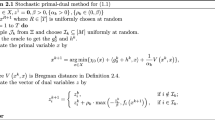Abstract
We deal with the primal–dual Newton method for linear optimization (LO). Nowadays, this method is the working horse in all efficient interior point algorithms for LO, and its analysis is the basic element in all polynomiality proofs of such algorithms. At present there is still a gap between the practical behavior of the algorithms and the theoretical performance results, in favor of the practical behavior. This is especially true for so-called large-update methods. We present some new analysis tools, based on a proximity measure introduced by Jansen et al., in 1994, that may help to close this gap. This proximity measure has not been used in the analysis of large-update methods before. The new analysis does not improve the known complexity results but provides a unified way for the analysis of both large-update and small-update methods.
Similar content being viewed by others
References
E.D. Andersen, J. Gondzio, Cs. Mészáros and X. Xu, Implementation of interior point methods for large scale linear programming, in: Interior Point Methods of Mathematical Programming, ed. T. Terlaky (Kluwer Academic, Dordrecht, The Netherlands, 1996) pp. 189–252.
K.M. Anstreicher, J. Ji, F.A. Potra and Y. Ye, Probabilistic analysis of an infeasible-interior-point algorithm for linear programming, Mathematics of Operations Research 24 (1999) 176–192.
E. de Klerk, C. Roos and T. Terlaky, On primal-dual path-following algortihms for semidefinite programming, in: New Trends in Mathematical Programming, eds. F. Gianessi et al., Applied Optimization, Vol. 13 (Kluwer Academic, Dordrecht, The Netherlands, 1998) pp. 137–157.
E. de Klerk, Interior point methods for semidefinite programming, Ph.D. Thesis, Faculty of ITS/TWI, Delft University of Technology, The Netherlands (1997).
A.V. Fiacco and G.P. McCormick, Nonlinear Programming: Sequential Unconstrained Minimization Techniques (Wiley, New York, 1968). Reprint: SIAM Classics in Applied Mathematics, Vol. 4 (SIAM Publications, Philadelphia, PA 19104–2688, USA, 1990).
R. Frisch, The logarithmic potential method for solving linear programming problems, Memorandum, University Institute of Economics, Oslo (1955).
B. Jansen, C. Roos, T. Terlaky and J.-Ph. Vial, Primal-dual algorithms for linear programming based on the logarithmic barrier method, Journal of Optimization Theory and Applications 83 (1994) 1–26.
J. Jiang, A long step primal-dual path following method for semidefinite programming, Operations Research Letters 23(1–2) (1998) 53–61.
N.K. Karmarkar, A new polynomial-time algorithm for linear programming, Combinatorica 4 (1984) 373–395.
M. Kojima, S. Mizuno and A. Yoshise, A primal-dual interior point algorithm for linear programming, in: Progress in Mathematical Programming: Interior Point and Related Methods, ed. N. Megiddo (Springer, New York, 1989) pp. 29–47.
M. Kojima, N. Megiddo, T. Noma and A. Yoshise, A Unified Approach to Interior Point Algorithms for Linear Complementarity Problems, Lecture Notes in Computer Science, Vol. 538 (Springer, Berlin, Germany, 1991).
F.A. Lootsma, Numerical Methods for Nonlinear Optimization (Academic Press, London, UK, 1972).
K.A. McShane, C.L. Monma and D.F. Shanno, An implementation of a primal-dual interior point method for linear programming, ORSA Journal on Computing 1 (1989) 70–83.
N. Megiddo, Pathways to the optimal set in linear programming, in: Progress in Mathematical Programming: Interior Point and Related Methods, ed. N. Megiddo (Springer, New York, 1989) pp. 131–158. Identical version in: Proceedings of the 6th Mathematical Programming Symposium of Japan, Nagoya, Japan (1986) pp. 1–35.
S. Mehrotra, On the implementation of a (primal-dual) interior point method, SIAM Journal on Optimization 2(4) (1992) 575–601.
S. Mehrotra and Y. Ye, On finding the optimal facet of linear programs, Mathematical Programming 62 (1993) 497–515.
S. Mizuno, An O(n3L) algorithm using a sequence for linear complementarity problems, Journal of the Operations Research Society of Japan 33 (1990) 66–75.
S. Mizuno, A primal-dual interior point method for linear programming, The Proceedings of the Institute of Statistical Mathematics 40(1) (1992) 27–44 (In Japanese).
S. Mizuno and A. Nagasawa, A primal-dual affine scaling potential reduction algorithm for linear programming, Mathematical Programming 62 (1993) 119–131.
R.D.C. Monteiro and I. Adler, Interior-path following primal-dual algorithms: Part I: Linear programming, Mathematical Programming 44 (1989) 27–41.
Y.E. Nesterov and M.J. Todd, Self-scaled barriers and interior-point methods for convex programming, Mathematics of Operations Research 22(1) (1997) 1–42.
C. Roos, T. Terlaky and J.-Ph. Vial, Theory and Algorithms for Linear Optimization. An Interior Approach (Wiley, Chichester, UK, 1997).
G. Sonnevend, An "analytic center" for polyhedrons and new classes of global algorithms for linear (smooth, convex) programming, in: System Modelling and Optimization: Proceedings of the 12th IFIP-Conference, Budapest, Hungary (September 1985), eds. A. Prekopa et al., Lecture Notes in Control and Information Sciences, Vol. 84 (Springer, Berlin, 1986) pp. 866–876.
M.J. Todd, A lower bound on the number of iterations of primal-dual interior-point methods for linear programming, in: Numerical Analysis 1993, eds. G.A. Watson and D.F. Griffiths, Pitman Research Notes in Mathematics, Vol. 303 (Longman Press, Harlow, (1994) pp. 237–259. See also [25].
M.J. Todd and Y. Ye, A lower bound on the number of iterations of long-step and polynomial interiorpoint linear programming algorithms, Annals of Operations Research 62 (1996) 233–252.
S.J. Wright, Primal-Dual Interior-Point Methods (SIAM, Philadelphia, USA, 1997).
Y. Ye, On the finite convergence of interior-point algorithms for linear programming, Mathematical Programming 57 (1992) 325–335.
Y. Ye, Interior Point Algorithms, Theory and Analysis (Wiley, Chichester, UK, 1997).
Y. Zhang and R.A. Tapia, Superlinear and quadratic convergence of primal-dual interior-point methods for linear programming revisited, Journal of Optimization Theory and Applications 73(2) (1992) 229–242.
G. Zhao, Large-step path-following primal-dual algorithms for linear programming, Research Report 613, National University of Singapore, Department of Mathematics, 10 Kent Ridge Crescent, Singapore 0511 (1994).
G.Y. Zhao, Interior point algorithms for linear complementarity problems based on large neighborhoods of the central path, SIAM Journal on Optimization 8 (1998) 397–413.
Author information
Authors and Affiliations
Rights and permissions
About this article
Cite this article
Peng, J., Roos, C. & Terlaky, T. New Complexity Analysis of the Primal—Dual Newton Method for Linear Optimization. Annals of Operations Research 99, 23–39 (2000). https://doi.org/10.1023/A:1019280614748
Issue Date:
DOI: https://doi.org/10.1023/A:1019280614748




